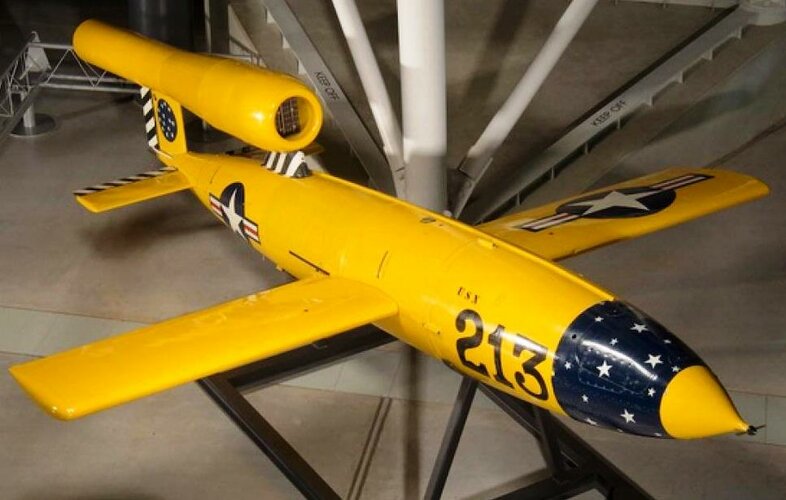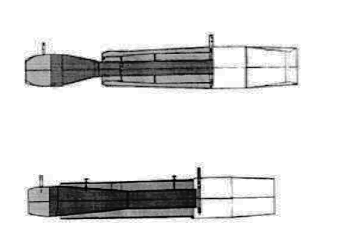My new website concerning the engine Argus As 014 from the V1 flying bomb :
My other websites concerning the V1 :
My other websites concerning the V1 :
@BAROBA, thanks for the link, if I have some time, I'll try this out.Fascinating read, thanks for making the site
I thought I knew something about the V-1, but now I know I knew nothing
I don't know if you know how to link pages together, but this page can help you.
Just ask if you need some help
Groeten,
Rob
Attached please find a side view of later versions of Argus pulse jet: Argus 109-014 and Argus 109-044, with a 'Trompe' added, improving thrust and fuel economy, able to use post-combustion. Somehow a Pulse-Stato jet.On May 29, 1944, Göring gave the order to alter the production of the Me 262 to transform it into Schnellbomber (fast bomber) and on June 7, the Führer confirmed its decision at a time when the interceptors were vital to the defence of the Reich. To escape this situation, Messerschmitt decided to revive the project P.1079 of 1941, under the new name Me 328.
It was a single seat fast bomber, built in wood and steel, capable of carrying a bomb of 1,000 kg to London. Its design was so simple that only 4,200 man-hours were needed for its construction, a quarter of the time used by a Bf 109 G. The secret was in its pulsejet engine type, a simple steel tube with very few moving parts and able to work with non-refined petrol Br-Stoff. Originally designed by Dipl. Ing. Paul Schmidt as SR 500, it had a maximum static thrust of 750 kp and could run for more than twenty hours at 700 kph.
But the improvement required too much time and the RLM chose to finance the construction of the Argus As 109-014, much simpler and with its valve system hosted in a quadrangular air-intake. The Argus pulsejet could not be throttled for lack of fuel pump, which had been removed to simplify the design. The fuel system was pressurized by means of compressed air bottles. The life of the flap valves was 20 minutes and only produced 366 kp thrust at 3,000 m ceiling. When mass manufacturing of the missile V-1 was ordered, the huge amount of orders of pulsejets saturated the production capacity of the manufacturer preventing any further refinement of the engine.
None of this was expected when Messerschmitt decided to build the Messerschmitt Me 328. With the SR 500 cancelled, it was anticipated that the Argus would get an upgraded version of the 014, with 400 kp thrust, capable of operating at 793 kph. It also existed as As 109-044, of 500 kp, and it was predictable that its manufacturing would start in 1945.
The first option of Messerschmitt had been the P.1079/1 project, a swept wing fast bomber powered by a SR 500, capable of carrying a bomb SD 1700 at 760 kph. Having to use the As 014, the fast bomber P.1079/16 (March 16, 1941) was redesigned in twin engine configuration with straight wing. It was expected to only reach a maximum speed of 530 kph, somewhat slower than a Spitfire Mk.II and that it would be a secure prey for the Tempests Mk.V that would try to hunt it in 1944.
To test the basic aerodynamics of the P.1079 /16, the DFS Institut was commissioned to build a flying mock-up with a wood/plywood. It was a small plane with classic shapes and a circular section fuselage that was used for initial aerodynamic trials, mounted above a Do 217 E-3 on a Mistelschlepp configuration. The special rig that held both aircraft was equipped with strain and pressure gauges to quantity the forces exerted on wings and tailfins during flight. The tests were initiated at Linz Hörsching airfield on July 23, 1941.
Doubts about the availability of the pulsejets kept the project frozen until mid-1943 when the construction of two prototypes for gliding tests were commissioned. The Me 328 V1 was built in wood/plywood by Jacobs-Schweyer Flugzeugbau GmbH in Darmstadt. The Me 328 V2 was commissioned to Kithelberger-Bregenz am Bodensee, had the nose fuselage and the tailfin built in light-alloy and the rest of the airframe in wood/plywood. The first flight tests of both prototypes were made in Hörsching using a Do 217 E-3 bomber with conventional Langseilschlepp cable-towing system. The take-off took place on a detachable dolly and the landing on a retractable ventral skid. They were launched from heights between 9,800 and 19,700 ft. During descent, both prototypes showed good characteristics of stability and manoeuvrability. Hanna Reitsch reached a speed of 600 kph piloting the V1 and estimated that its maximum speed in dive could reach 730 kph.
In April 1944 flight tests started with two pulsejets VSR-7, an older version of Argus 109-014 with external fuel pumps, during which both prototypes suffered structural damage due to sonic shockwaves produced by this type of engine. Although according to some sources the wings were destroyed by vibration and not by sound. The operation of two VSR-7 could not be synchronized in flight as the pilot lacked effective control over the fuel pumps that had been installed to replace the pressurized air fuel system. The fuel pumps were powered by electric engines and the electricity to operate them came from two wind-driven generators in the wings, originally designed for the Me 163. To solve the problem of vibrations, it was decided to install the pulsejets to both sides of the rear section of the fuselage, which in the V3 prototype had been built of metallic structure and coating by Gothaer Waggonfabrik.
In late 1943, flight tests of the Messerschmitt Me 328 V3 transported on a bomber Do 217 in Mistelschlepp configuration started in Hörschling-Linz airfield. The plane was the prototype of the future Me 328 A, the fighter version of the programme. At an altitude of 18,000 ft the carrier plane started a shallow dive to facilitate ignition of the two experimental pulsejets Argus VSR-7 attached to both sides of the fuselage of the prototype. After launch, the pilot verified that the engines lost thrust quickly and were unable to maintain the flight altitude of the Me 328 V3 until coming down to 9,000 ft when the engines returned to normal.
Subsequent tests showed that this type of engines were useful only when the plane was flying at relatively low altitudes and speeds and the RLM concluded that the Me 328 could not be used as a fighter. Accordingly the new series of pulsejets VSR-9a was assigned to the Fieseler firm to power the V-1 missiles. Mass production of 32,000 engines of this model, officially called Argus As 109-014, completely monopolized the manufacturer resources, but research to improve the performances of pulsejets continued in the laboratories of AVA, LFA, DFS and FKFS until the end of the war in Europe.
One of its first achievements was the As 109-044, an improved version of the 109-014 with 660 kp thrust, with a new combustion chamber of 75 cm diameter. For his part, Prof. Dr. Ruden managed to increase the thrust of the 109-014 in 60 kp by improving the aerodynamics of the air-intake. Much more difficult was to solve the problem resulted from the loss of thrust at high altitude and speed, fortunately for the British, as the low speed of the V-1 allowed its interception by conventional piston fighters.
In 1944, gas dynamicist Dipl.Ing. Schulz-Grunow designed an air-intake to reduce the air pressure in front of the valves that prevented the loss of thrust when the missile flew at high speed. Dipl.Ing. Fritz-Gosslau designed a rotating flap-valve to extend the useful life of pulsejet beyond the 20 minutes of the basic design. Dr. Guenter Driedrich worked on a miniature pulsejet since 1943 that had been originally conceived as auxiliary equipment to heat aircraft engines. In late 1944, the DFS-Ainring Institut brought together all these lines of research in a project of pulsejet engine for the DFS Eber and the DVL Jagdsegler fighters, capable of operating at full capacity at 26,000 ft and 900 kph.
In its initial release, of only 200 kp thrust, it was 160 cm long with a combustion chamber diameter of 33 cm. Fuel consumption was only 2.2 litres per minute and its maximum useful life was of 90 minutes. The air duct was shaped like an 'S' and the intake cap was made by a pointed fairing and flush annular slot. This device allowed the valves system to admit air at atmospheric pressure, regardless of the height and speed of flight.

 Blessings +
Blessings +Does anyone now of sizes for the schmidt sr500 pulsejet? The one that is in the Messerschmitt 1079 drawings.
this is completely false.On May 29, 1944, Göring gave the order to alter the production of the Me 262 to transform it into Schnellbomber (fast bomber) and on June 7, the Führer confirmed its decision at a time when the interceptors were vital to the defence of the Reich. To escape this situation, Messerschmitt decided to revive the project P.1079 of 1941, under the new name Me 328.
Sometimes it's more polite to ask about sourcesthis is completely false.
in Speers autobiography he clearly states that the very idea and demand to turn or optimise the 262 as a Jabo instead of a fighter came from WILLY MESSERSCHMITT with Goring and Hitler needing alot of persuading to get onboard with that idea. with Hitler initially flat out rejecting the idea but eventually compromising with every 50th airframe will be a fighter bomber untill 1000 262s are made wherater the 262 was to be exclusively a fighter
this site should be renamed "bash on Germany and deny reality"
Here is a link about renewed interest in the pulse jet developmentAnyway, Me-262 seems had problems as fighter, pilots and aiming devices not adapted to speed, had to reduce it for shot, being for a while at the reach of bombers' artillery.
The late approach of having a photocell triggering rockets aimed 45° upwards when under a bomber shadow gave good results.
SFC of last versions of Argus 109, Pulse-Ramjets, also with afterburner, see 'El motor de Aviación de la A a la Z', Ricard Miguel Vidal, Aeroteca, Barcelona, open access for members in enginehistory.org site, is reported as 1.1, similar to small turbines as Turbomeca Marboré, the Pulsejet much lighter, easier to build.
Blessings +

